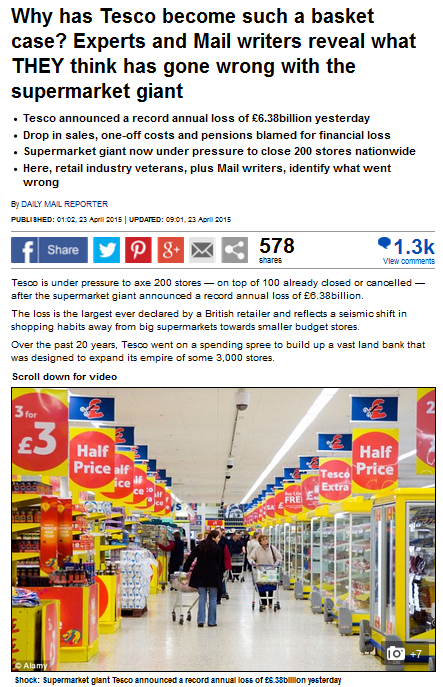Does your business have a ‘Tesco strategy’?
The papers this week are full of Tesco as it plunged to its worst-ever pre-tax loss of £6.38bn.
There is plenty of discussion around its strategy and ‘where did it go wrong?’ For years, Tesco was ‘cheap’ but in recent years it has tried to be all things to all people without a clearly differentiated strategy.
Lord Haskins, former chair of Northern Foods, sums this up beautifully in the Mail’s article on ‘why has Tesco become such a basket case?’ He says “Tesco’s problem is that it tried to be all things to all men. It has vast stores that want to be an M&S and a Lidl all in one.
“Asda concentrates on the cheap-and-cheerful market, while Waitrose still targets the top end of the market, and both are successful for keeping it more simple.”
It is surprising how even the most experienced of directors and boards can muddle up strategies. Trying to do operational excellence, customer intimacy and compete with the cheapest, altogether, is not possible. As Tesco has found, you will fail because you will be beaten by rivals who are more clearly focussed.
Perhaps the most telling sign that Tesco’s business was not aligned with its strategy was that they had four private jets.
In all my years of running executive education programmes for businesses large and small across the world, rarely have I been in a business where all the leaders can clearly articulate their strategy.
Just as with Tesco, often the strategy itself is confused and the business wants to be all things for their customer – give the customer what they say they really want, have lean operational processes and innovate with their products and services. Our argument is that you can’t win and be a leader in your market – and more importantly build a highly profitable business – unless you focus on one area to excel in.
And even if the strategy itself is focused, when you get leaders to articulate it they all explain it in different ways. I have done this as an exercise with some businesses and at the end even the directors are wondering if they all work in the same business!
The strategy is critical to the whole business – it has real implications on culture, how you manage the business, operationalizing the strategy – your structures and processes, aligning performance management behind it; and how you keep the strategy refreshed. Strategies are dynamic.
Treacy and Wiersema said a good strategy should focus on one of the 3 disciplines of market leaders: product leadership , customer intimacy or operational excellence
I have only ever come across one business who were able at the first meeting to tell me what their chosen strategy was – their case product leadership. This enabled us to work with them on implementing that strategy and align the whole business behind it.
Most businesses need the challenge we can provide through an executive education programme in working through which of the 3 value disciplines would give them greatest success.
“What is your strategy”? – if I asked you that question now, would you be able to articulate it in a confident and compelling way?









